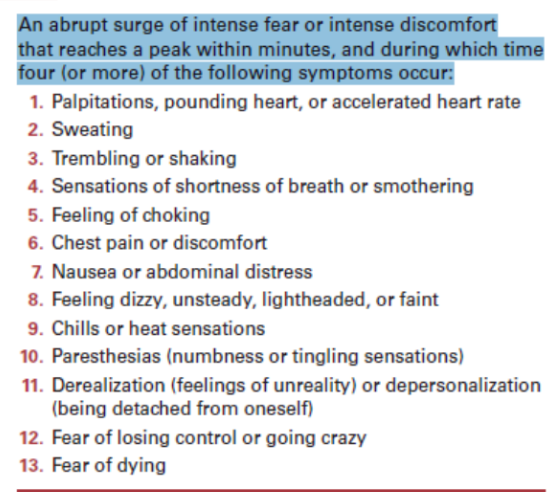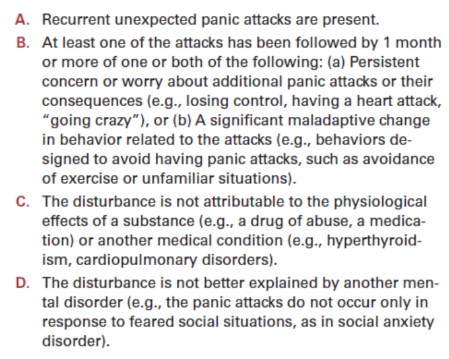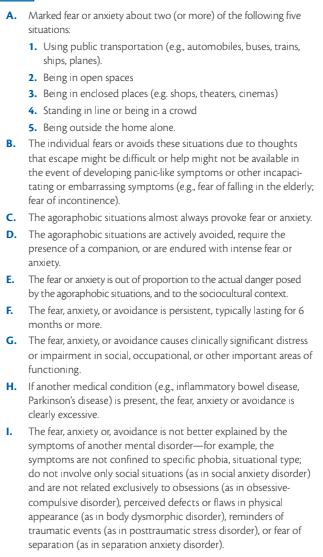Abnormal Psychology - CHAPTER 5
1/77
Earn XP
Description and Tags
Anxiety, Trauma-and Stressor-Related, and Obsessive-Compulsive and Related Disorders
Name | Mastery | Learn | Test | Matching | Spaced |
|---|
No study sessions yet.
78 Terms
Anxiety
Future-oriented negative mood state characterized by bodily symptoms of physical tension and by apprehension about the future
True
True or False: Anxiety is good for us in moderate amount
True
True or False: Social, physical, and intellectual performances are driven and enhanced by anxiety
Howard Liddell
He called anxiety the “shadow of intelligence”
Anxiety
A future oriented mood state characterized by apprehension because we cannot predict or control upcoming events.
True
True or False: Severe anxiety usually doesn’t go away
Fear
An immediate emotional reaction to current danger characterized by strong escapist action tendencies and, often, a surge in the sympathetic branch of the autonomic nervous system
Fear
It protects us by activating a massive response from the autonomic nervous system
Fear
Motivates us to escape or possibly attack
Flight or Fight Response
Emergency reaction that motivates us to escape or possibly to attack
Panic
Alarm response of fear when there is nothing to be afraid of
Panic attack
It is defined as an abrupt experience of intense fear or acute discomfort, accompanied by physical symptoms that usually include heart palpitations, chest pain, shortness of breath, and, possibly, dizziness.
Expected and Unexpected (Cued and Uncued)
The two basic types of panic attacks described in the DSM-5
Expected (cued) attacks
More common in specific phobias or social anxiety disorder
True
True or False: The experience of panic attacks is an important severity marker and predictor of persistence of any anxiety disorder across the life span
True
True or False: We inherit a tendency to be tense, uptight, and anxious
False
True or False: The tendency to panic does not run in the family
True
True or False: No single gene seems to cause anxiety or panic or any other psychiatric disorder
False
True or False: A genetic vulnerability cause anxiety and/or panic directly
True
True or False: Stress or other factors in the environment can “turn on” or “turn off” certain genes
GABA (gamma-aminobutyric acid)
Depleted levels of this neurotransmitter are associated with increased anxiety (the relationship is not quite direct)
Noradrenergic system (norepinephrine/noradrenaline) and Serotonergic neurotransmitter system
Two neurotransmitter that are also implicated in anxiety
Corticotropin-releasing factor (CRF) system
This is central to the expression of anxiety (depression)
Limbic system
The area of the brain is most often associated with anxiety. It also acts as a mediator between the brain stem and cortex.
Behavioral Inhibition System (BIS)
This is activated by signals from the brain stem of unexpected events, such as major changes in body functioning that might signal danger.
Fight/Flight System (FFS)
Produces an immediate alarm-and-escape response that looks very much like panic in humans.
True
True or False: Cigarette smoking as a teenager is associated with greatly increased risk for developing anxiety disorders as an adult.
Distress tolerance
The amount of distress a person can tolerate
Anhedonia
This is the inability to feel pleasure
True
True or False: A sense of control (or lack of it) that develops from early experiences is the psychological factor that makes us more or less vulnerable to anxiety in later life.
Anxiety sensitivity
The tendency to respond fearfully to anxiety symptoms
External cues
Places or situations similar to the one where the initial panic attack occurred.
Internal cues
These are increases in heart rate or respiration that were associated with the initial panic attack, even if they are merely the result of exercise or other routine activities
True
True or False: You may not be aware of the cues or triggers of severe fear (unconscious)
Triple Vulnerability Theory
Theory of the development of anxiety
Generalized biological vulnerability
The first vulnerability
This is not sufficient enough to produce anxiety itself
“Glass is half empty”
Irritable
Driven
Generalized psychological vulnerability
The second vulnerability
Sense that events are uncontrollable/unpredictable
You might not be able to cope when things go wrong based on your early experiences
Tendency toward lack of self-confidence
Low self-esteem
Inability to cope
Specific psychological vulnerability
The third vulnerability
You learn from early experience that some situations or objects are fraught with danger
Ex: physical sensations are potentially dangerous
Anxiety about health?
Nonclinical panic?
True
True or False: Anxiety is usually focused on one area
True
True or False: Anxiety increases the likelihood of panic
Comorbidity
The co-occurrence of two or more disorders in a single individual
Process-based therapy
This is for therapy to be effective, it needs to target the underlying processes of change rather than the DSM-defined psychiatric syndromes.
Major depression
The most common additional diagnosis for all anxiety disorders
True
True or False: Additional diagnosis of depression or alcohol use disorder or drug use or misuse makes it less likely that you will recover from an anxiety disorder and more likely that you will relapse if you do recover
True
True or False: Any anxiety or related disorder uniquely increases the chances of having thought about suicide or making suicidal attempts.
Suicidal Ideation
Described as having thoughts about suicide
Generalized Anxiety Disorder (GAD)

Generalized Anxiety Disorder (GAD)
Worrying never stops meaning turning to the next crisis as soon as the current one was over
Generalized Anxiety Disorder (GAD)
People with this disorder mostly worry about minor everyday life events
Panic Attack

False
True or False: About twice as many individuals with GAD are male than female in epidemiological studies
True
True or False: Once it develops, GAD is chronic
Benzodiazepines
This is the most prescribed for GAD. They give short term relief for a temporary crisis or stressful event
Antidepressant: Paroxetine (Paxil) and Venlafaxine (Effexor)
There is stronger evidence for the usefulness of these drugs in the treatment of GAD. Better choice than Benzodiazepines
False
True or False: Psychological treatments are less effective in the long run
Panic Disorder (PD)
People with this disorder experience severe, unexpected panic attacks. They may think they are dying or losing control.
Panic Disorder (PD)

Agoraphobia
Fear and avoidance of situations in which a person feels unsafe or unable to escape to get home or to a hospital in the event of a developing panic, panic-like symptoms, such as loss of bladder control.
Agoraphobia
Severe cases of this disorder include not being being able to leave the house, sometimes for years on end.
Unexpected panic attack
To meet the criteria for Panic Disorder (PD) a person must experience an ________ and develop substantial anxiety over the possibility of having another attack or about the implications of the attack or its consequences
Karl Westphal
Agoraphobia was coined in 1871 by whom
True
True or False: people with agoraphobia always plan for rapid escape
True
True or False: People with agoraphobia may either avoid situations or endure them with intense fear and anxiety
Interoceptive avoidance
The avoidance of internal physical sensations; removing oneself from situations or activities that might produce the physiological arousal that somehow resembles the beginnings of a panic attack
False
True or False: Most of those who suffer from agoraphobia are men
Agoraphobia

Nocturnal attacks
Panic attacks that occur more often between 1:30am and 3:30am. This also occurs during delta wave or slow-wave sleep (deepest stage of sleep)
Learned alarms
Cues become associated with a number of different internal and external stimuli through a learning process
Medication for panic disorders
High-potency benzodiazepines such as alprazolam (Xanax), the newer selective serotonin reuptake inhibitors (SSRIs) such as Prozac and Paxil, and the closely related serotonin-norepinephrine reuptake inhibitors (SNRIs), such as venlafaxine
Psychological Intervention for Agoraphobia
Exposure therapy combined with anxiety-reducing coping mechanisms such as relaxation or breathing retraining
Panic Control treatment (PCT)
Exposing patients with panic disorder to the cluster of interoceptive (physical) sensations that remind them of their panic attacks.
True
True or False: Psychological treatments seemed to perform better in the long run